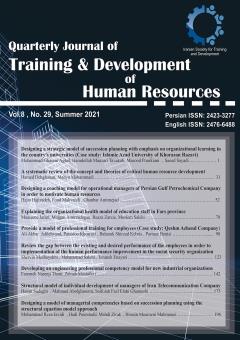-
-
List of Articles
-
Open Access Article
1 - Designing a strategic model of succession planning with emphasis on organizational learning in the country's universities (Case study: Islamic Azad University of Khorasan Razavi)
Mohammad Ghasem Aghel hamdolah manzari tavakoli Masoud Pouekiani saeid sayadi -
Open Access Article
2 - Designing a coaching model for operational managers of Persian Gulf Petrochemical Company in order to motivate human resources
Hajat hajizadeh Foad Makvandi Ghanbar Amirnejad -
Open Access Article
3 - Providing a model of professional training for employees (Case study: Qeshm Azhend Company)
aliakbar jalilehvand parastoo khosravi Baharak Shirzad Kebria Parinaz Benisi -
Open Access Article
4 - Reviewing a systematic of the concept and theories of critical human resource development
hamed dehghanan Mahya Mohammadi -
Open Access Article
5 - Structural model of individual development of managers of Iran Telecommunication Company
Hassan Saddoghi Mahmood Abolghasemi Seyfollah Fazlollahi ghomshi -
Open Access Article
6 - Explaining the organizational health model of education staff in Fars province
Maasume Jaafari Mojgan Amirianzadeh reza zarei moslem Salehi -
Open Access Article
7 - Designing a model of managerial competencies based on succession planning using the structural equation model approach
Mohammad Reza Javidi Hadi pourshafei Mehdi Zirak Hossein Momeni Mahmavi -
Open Access Article
8 - Developing a model of professional competencies of engineers for industrial modern organizations
Fatemeh Narenji thani Zeinab Sadat Mostafavi -
Open Access Article
9 - Review the gap between the existing and desired performance of the employees in order to implementation of the human performance improvement in the social security organization
SHERVIN MASHAYEKHI Mohammad salehi TARANEH ENAYATI
-
The rights to this website are owned by the Raimag Press Management System.
Copyright © 2017-2026







